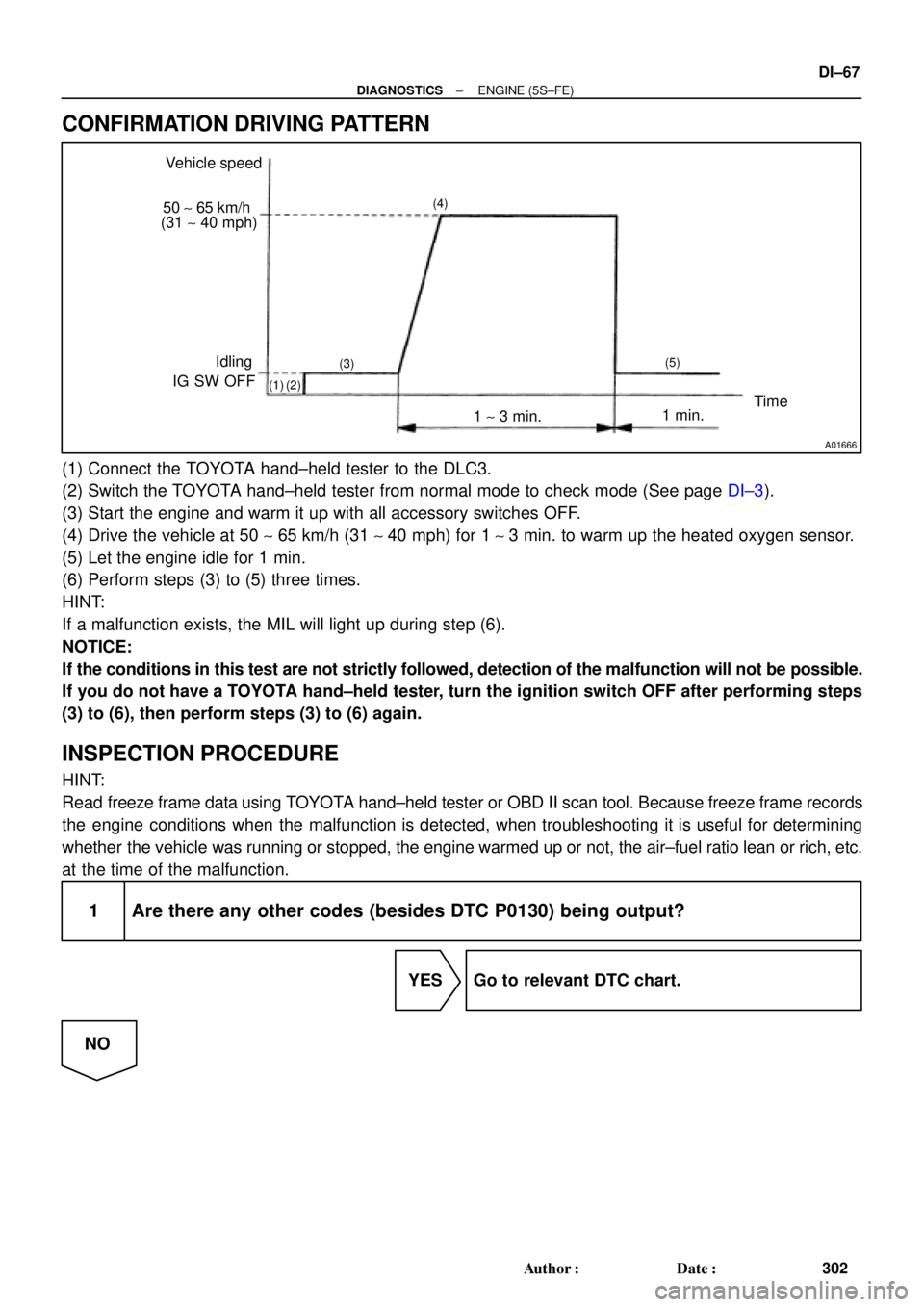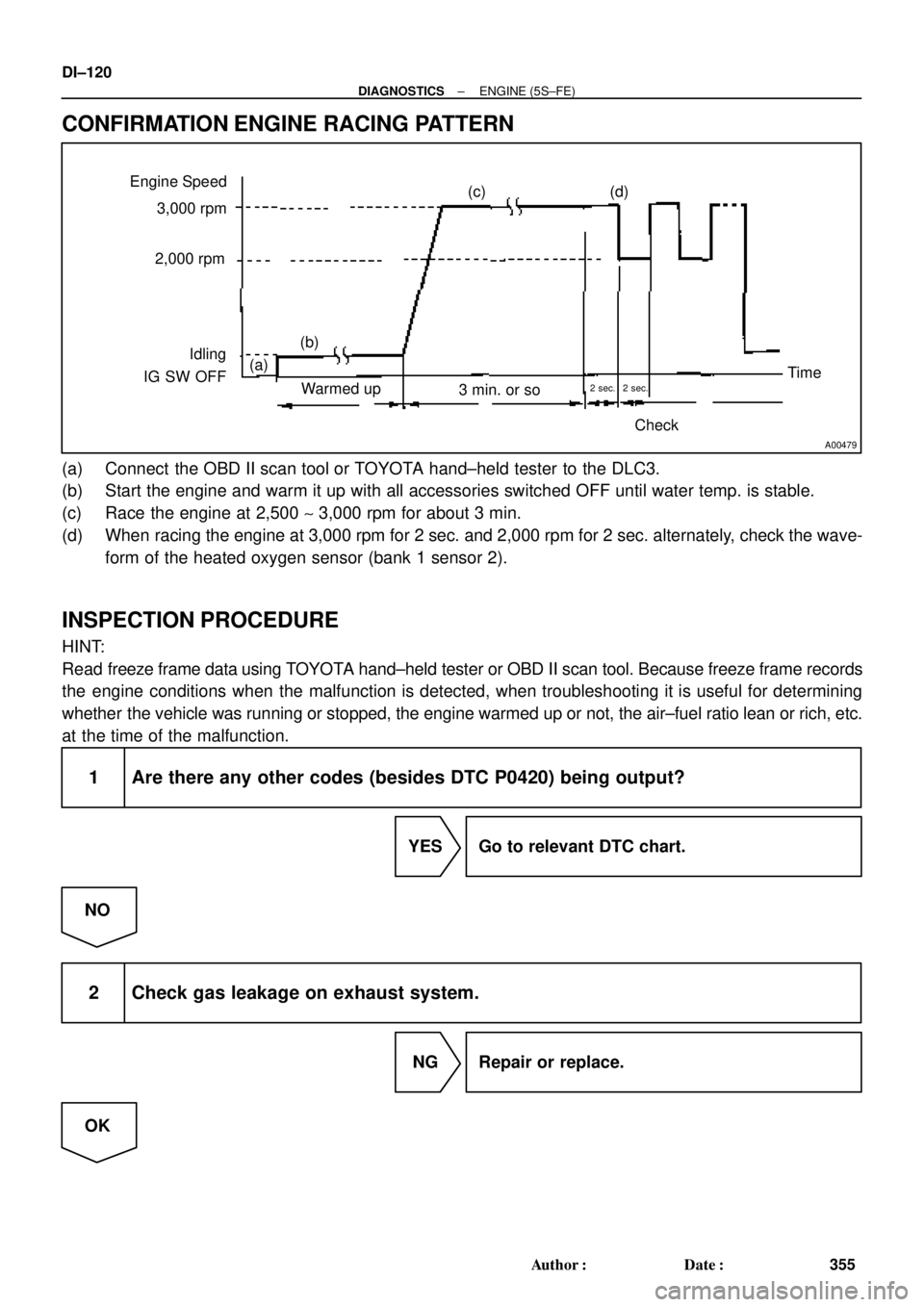Page 2483 of 4770
± DIAGNOSTICSENGINE (5S±FE)
DI±63
298 Author�: Date�:
1 Are there any other codes (besides DTC P0125) being output?
YES Go to relevant DTC chart.
NO
2 Connect OBD II scan tool or TOYOTA hand±held tester, and read value for volt-
age output of heated oxygen sensor (bank 1 sensor 1).
PREPARATION:
(a) Connect the OBD II scan tool or TOYOTA hand±held tester to the DLC3.
(b) Warm up the engine to normal operating temp. (above 75°C (169°F)).
CHECK:
Read voltage output of the heated oxygen sensor (bank 1 sensor 1) when the engine is suddenly raced.
HINT:
Perform quick racing to 4,000 rpm 3 times using the accelerator pedal.
OK:
Heated oxygen sensor (bank 1 sensor 1) output a RICH signal (0.45 V or more) at least once.
OK Go to step 10.
NG
3 Check for open and short in harness and connector between ECM and heated
oxygen sensor (bank 1 sensor 1) (See page IN±31).
NG Repair or replace harness or connector.
OK
Page 2487 of 4770

A01666
Vehicle speed
50 ~ 65 km/h
(31 ~ 40 mph)
Idling
IG SW OFF
(1)
1 ~ 3 min.1 min.Time
(2)(3)(4)
(5)
± DIAGNOSTICSENGINE (5S±FE)
DI±67
302 Author�: Date�:
CONFIRMATION DRIVING PATTERN
(1) Connect the TOYOTA hand±held tester to the DLC3.
(2) Switch the TOYOTA hand±held tester from normal mode to check mode (See page DI±3).
(3) Start the engine and warm it up with all accessory switches OFF.
(4) Drive the vehicle at 50 ~ 65 km/h (31 ~ 40 mph) for 1 ~ 3 min. to warm up the heated oxygen sensor.
(5) Let the engine idle for 1 min.
(6) Perform steps (3) to (5) three times.
HINT:
If a malfunction exists, the MIL will light up during step (6).
NOTICE:
If the conditions in this test are not strictly followed, detection of the malfunction will not be possible.
If you do not have a TOYOTA hand±held tester, turn the ignition switch OFF after performing steps
(3) to (6), then perform steps (3) to (6) again.
INSPECTION PROCEDURE
HINT:
Read freeze frame data using TOYOTA hand±held tester or OBD II scan tool. Because freeze frame records
the engine conditions when the malfunction is detected, when troubleshooting it is useful for determining
whether the vehicle was running or stopped, the engine warmed up or not, the air±fuel ratio lean or rich, etc.
at the time of the malfunction.
1 Are there any other codes (besides DTC P0130) being output?
YES Go to relevant DTC chart.
NO
Page 2491 of 4770

± DIAGNOSTICSENGINE (5S±FE)
DI±71
306 Author�: Date�:
DTC P0133 Heated Oxygen Sensor Circuit Slow Re-
sponse (Bank 1 Sensor 1) (Ex. CA Spec.)
CIRCUIT DESCRIPTION
Refer to DTC P0125 (Insufficient Coolant Temp. for Closed Loop Fuel Control (Except California Spec.)) on
page DI±55.
DTC No.DTC Detecting ConditionTrouble Area
P0133
Response time for heated oxygen sensor's voltage output to
change from rich to lean, or from lean to rich, is 1 sec. or more
during idling after engine is warmed up
(2 trip detection logic)
�Heated oxygen sensor
�Fuel trim malfunction
HINT:
Sensor 1 refers to the sensor closer to the engine body.
INSPECTION PROCEDURE
HINT:
Read freeze frame data using TOYOTA hand±held tester or OBD II scantool. Because freeze frame records
the engine conditions when the malfunction is detected, when troubleshooting it is useful for determining
whether the vehicle was running or stopped, the engine warmed up or not, the air±fuel ratio lean or rich, etc.
at the time of the malfunction.
1 Are there any other codes (besides DTC P0133) being output?
YES Go to relevant DTC chart.
NO
DI4NF±01
Page 2497 of 4770

± DIAGNOSTICSENGINE (5S±FE)
DI±77
312 Author�: Date�:
DTC P0136 Heated Oxygen Sensor Circuit Malfunction
(Bank 1 Sensor 2)
CIRCUIT DESCRIPTION
Refer to DTC P0125 (Insufficient Coolant Temp. for Closed Loop Fuel Control (Except California Spec.)) on
page DI±55.
DTC No.DTC Detecting ConditionTrouble Area
P0136
Voltage output of heated oxygen sensor remains at
0.45*
1/0.40*2 V or more, or 0.60*1/0.50*2 V or less when ve-
hicle is driven at 40 km/h (25 mph) or more after engine is
warmed up
*
1: for California Spec.
*
2: except California Spec.
(2 trip detection logic).
�Heated oxygen sensor
HINT:
Sensor 2 refers to the sensor farther away from the engine body.
WIRING DIAGRAM
Refer to DTC P0125 (Insufficient Coolant Temp. for Closed Loop Fuel Control (Except California Spec.)) on
page DI±55.
INSPECTION PROCEDURE
HINT:
Read freeze frame data using TOYOTA hand±held tester or OBD II scan tool. Because freeze frame records
the engine conditions when the malfunction is detected, when troubleshooting it is useful for determining
whether the vehicle was running or stopped, the engine warmed up or not, the air±fuel ratio lean or rich, etc.
at the time of the malfunction.
1 Are there any other codes (besides DTC P0136) being output?
YES Go to relevant DTC chart.
NO
DI00Y±08
Page 2509 of 4770

± DIAGNOSTICSENGINE (5S±FE)
DI±89
324 Author�: Date�:
DTC P0300 Random/Multiple Cylinder Misfire Detected
DTC P0301 Cylinder 1 Misfire Detected
DTC P0302 Cylinder 2 Misfire Detected
DTC P0303 Cylinder 3 Misfire Detected
DTC P0304 Cylinder 4 Misfire Detected
CIRCUIT DESCRIPTION
Misfire: The ECM uses the crankshaft position sensor and camshaft position sensor to monitor changes in
the crankshaft rotation for each cylinder.
The ECM counts the number of times the engine speed change rate indicates that misfire has occurred. And
when the misfire rate equals or exceeds the count indicating that the engine condition has deteriorated, the
MIL lights up.
If the misfire rate is high enough and the driving conditions will cause catalyst overheating, the MIL blinks
when misfiring occurs.
DTC No.DTC Detecting ConditionTrouble Area
P0300Mi fi i f d li d i d t t d d i ti l
�Ignition system
�Injector
�Fuel line pressure
�EGR
P0300
P0301
P0302
P0303
P0304
Misfiring of random cylinders is detected during any particular
200 or 1,000 revolutions
For any particular 200 revolutions for engine, misfiring is de-
tected which can cause catalyst overheating
(This causes MIL to blink)
�EGR
�Compression pressure
�Valve clearance not to specification
�Valve timing
�Manifold absolute pressure sensor
P0304(This causes MIL to blink)�Manifold absolute ressure sensor
�Engine coolant temp. sensor
�Open or short in engine wire
�Connector connection
�ECM
HINT:
When the 2 or more codes for a misfiring cylinder are recorded repeatedly but no random misfire code is
recorded, it indicates that the misfires were detected and recorded at different times.
DI011±07
Page 2538 of 4770
DI±118
± DIAGNOSTICSENGINE (5S±FE)
353 Author�: Date�:
INSPECTION PROCEDURE
HINT:
Read freeze frame data using TOYOTA hand±held tester or OBD II scan tool. Because freeze frame records
the engine conditions when the malfunction is detected, when troubleshooting it is useful for determining
whether the vehicle was running or stopped, the engine warmed up or not, the air±fuel ratio lean or rich, etc.
at the time of the malfunction.
1 Are there any other codes (besides DTC P0420) being output?
YES Go to relevant DTC chart.
NO
2 Check gas leakage on exhaust system.
NG Repair or replace.
OK
3 Check heated oxygen sensor (bank 1 sensor 1) (See page DI±66).
NG Repair or replace.
OK
4 Check heated oxygen sensor (bank 1 sensor 2) (See page DI±77).
NG Repair or replace.
OK
Replace three±way catalytic converter.
Page 2540 of 4770

A00479
Engine Speed
3,000 rpm
Idling
IG SW OFF
Warmed up
3 min. or so
CheckTime (a)(c) (d)
(b) 2,000 rpm
2 sec. 2 sec.
DI±120
± DIAGNOSTICSENGINE (5S±FE)
355 Author�: Date�:
CONFIRMATION ENGINE RACING PATTERN
(a) Connect the OBD II scan tool or TOYOTA hand±held tester to the DLC3.
(b) Start the engine and warm it up with all accessories switched OFF until water temp. is stable.
(c) Race the engine at 2,500 ~ 3,000 rpm for about 3 min.
(d) When racing the engine at 3,000 rpm for 2 sec. and 2,000 rpm for 2 sec. alternately, check the wave-
form of the heated oxygen sensor (bank 1 sensor 2).
INSPECTION PROCEDURE
HINT:
Read freeze frame data using TOYOTA hand±held tester or OBD II scan tool. Because freeze frame records
the engine conditions when the malfunction is detected, when troubleshooting it is useful for determining
whether the vehicle was running or stopped, the engine warmed up or not, the air±fuel ratio lean or rich, etc.
at the time of the malfunction.
1 Are there any other codes (besides DTC P0420) being output?
YES Go to relevant DTC chart.
NO
2 Check gas leakage on exhaust system.
NG Repair or replace.
OK
Page 2573 of 4770

A00364
Vehicle Speed
60 ~ 120 km/h
(38 ~ 75 mph)
Idling
IG SW OFF
3 ~ 5 min.
Time
(1)(2)(4)
(3)
± DIAGNOSTICSENGINE (5S±FE)
DI±153
388 Author�: Date�:
CONFIRMATION DRIVING PATTERN
(1) Connect the TOYOTA hand±held tester to the DLC3.
(2) Switch the TOYOTA hand±held tester from normal mode to check mode (See page DI±3).
(3) Start the engine and warm it up with all accessory switches OFF.
(4) Drive the vehicle at 60 ~ 120 km/h (38 ~ 75 mph) and engine speed at 1,600 ~ 3,200 rpm for 3
~ 5 min.
HINT:
If a malfunction exists, the MIL will light up during step (4).
NOTICE:
If the conditions in this test are not strictly followed, detection of the malfunction will not be possible.
If you do not have a TOYOTA hand±held tester, turn the ignition switch OFF after performing steps
(3) and (4), then perform steps (3) and (4) again.
INSPECTION PROCEDURE
HINT:
Read freeze frame data using TOYOTA hand±held tester or OBD II scan tool. Because freeze frame records
the engine conditions when the malfunction is detected, when troubleshooting it is useful for determining
whether the vehicle was running or stopped, the engine warmed up or not, the air±fuel ratio lean or rich, etc.
at the time of the malfunction.
1 Are there any other codes (besides DTC P1130) being output?
YES Go to relevant DTC chart.
NO